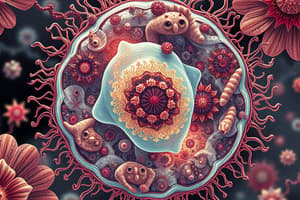Podcast
Questions and Answers
Robert Hooke used a microscope to examine a thin sliced of cork of plants. He described the image he saw as a “great many little boxes” DISCOVERY OF THE
Robert Hooke used a microscope to examine a thin sliced of cork of plants. He described the image he saw as a “great many little boxes” DISCOVERY OF THE
cell
The first person to observe living cell was a Dutch microscope marker Anton van Leuwenhoek. Leeuwenhoek's microscope was rather simple. 4 CELL THEORY This theory describes conclusions made about ______ after 150 years of studying ______. 1. 2. 3. All living things are composed of one or more ______ Cells are the basic unit of structure and function in an organism. Cells come only from the reproduction of existing ______ 5 ❑ ❑ ❑ Early evidence for the cell theory was provided by the German scientists: The botanist Matthias Schleiden concluded that all plants are composed of ______. Then the zoologist Theodor Schwann concluded that all animals are composed of ______. 6 Cell Diversity Even ______ within the same organism may show enormous diversity in size, shape, and internal organization size Most plant and animal ______ are only about 10 – 50 nm in diameter and some bacterial ______ are only 0.2 nm in diameter. Therefore ,most ______ are visible only with a microscope.
The first person to observe living cell was a Dutch microscope marker Anton van Leuwenhoek. Leeuwenhoek's microscope was rather simple. 4 CELL THEORY This theory describes conclusions made about ______ after 150 years of studying ______. 1. 2. 3. All living things are composed of one or more ______ Cells are the basic unit of structure and function in an organism. Cells come only from the reproduction of existing ______ 5 ❑ ❑ ❑ Early evidence for the cell theory was provided by the German scientists: The botanist Matthias Schleiden concluded that all plants are composed of ______. Then the zoologist Theodor Schwann concluded that all animals are composed of ______. 6 Cell Diversity Even ______ within the same organism may show enormous diversity in size, shape, and internal organization size Most plant and animal ______ are only about 10 – 50 nm in diameter and some bacterial ______ are only 0.2 nm in diameter. Therefore ,most ______ are visible only with a microscope.
cells
Cell is the smallest unit of matter that can carry on all of the processes of life. ◦ 1n 1665, English scientist
Cell is the smallest unit of matter that can carry on all of the processes of life. ◦ 1n 1665, English scientist
Robert Hooke
Most plant and animal cells are only about 10 – 50 nm in diameter and some bacterial cells are only 0.2 nm in diameter. Therefore ,most cells are ______.
Most plant and animal cells are only about 10 – 50 nm in diameter and some bacterial cells are only 0.2 nm in diameter. Therefore ,most cells are ______.
All living things are composed of one or more cells Cells are the basic unit of structure and function in an organism. Cells come only from the reproduction of existing cells 5 ❑ ❑ ❑ Early evidence for the cell theory was provided by the German scientists: The botanist Matthias Schleiden concluded that all plants are ______. Then the zoologist Theodor Schwann concluded that all animals are ______. 6 Cell Diversity Even cells within the same organism may show enormous diversity in size, shape, and internal organization size Most plant and animal cells are only about 10 – 50 nm in diameter and some bacterial cells are only 0.2 nm in diameter. Therefore ,most cells are
All living things are composed of one or more cells Cells are the basic unit of structure and function in an organism. Cells come only from the reproduction of existing cells 5 ❑ ❑ ❑ Early evidence for the cell theory was provided by the German scientists: The botanist Matthias Schleiden concluded that all plants are ______. Then the zoologist Theodor Schwann concluded that all animals are ______. 6 Cell Diversity Even cells within the same organism may show enormous diversity in size, shape, and internal organization size Most plant and animal cells are only about 10 – 50 nm in diameter and some bacterial cells are only 0.2 nm in diameter. Therefore ,most cells are
Flashcards are hidden until you start studying




